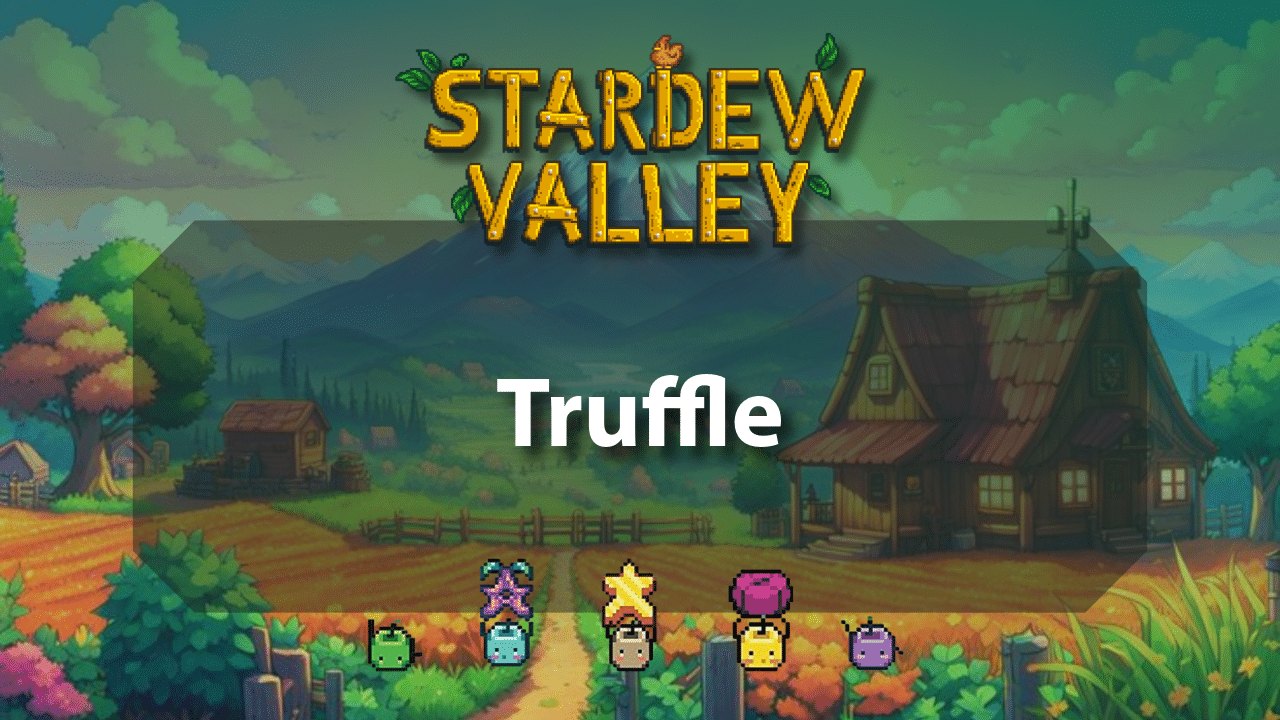
Embarking on Your Truffle Farming Adventure
Stardew Valley Truffle farming is one of the most profitable ventures for players looking to maximize their income. Truffles are a valuable resource that can only be obtained by raising pigs, which will dig them up while wandering outside on non-winter days with clear weather. To start, you’ll need a Deluxe Barn, as pigs are only available at this upgrade level. Once purchased, pigs must be allowed outside to forage, and the more pigs you have, the higher your chances of finding multiple truffles daily.
Truffles can be sold directly for a solid profit, but turning them into Truffle Oil using an Oil Maker increases their value even further, making it a great option for players focusing on artisan goods. Ensuring pigs are well-fed and happy will maximize their Stardew Valley truffle production, so keeping them inside during rainy days and providing heaters in winter helps maintain their mood. Stardew Valley Truffle farming is a rewarding long-term investment that, with proper care and expansion, can generate a steady stream of high-income opportunities throughout the year.
Setting Up Your Pig Paradise
Before you can start raising pigs in Stardew Valley, you’ll need to upgrade your barn to a Deluxe Barn, as pigs can only be housed there. Upgrading from a Big Barn to a Deluxe Barn requires 25,000 gold, 550 wood, and 300 stone, while building one from scratch costs 43,000 gold, 1,350 wood, and 650 stone. This upgrade is essential because it not only allows you to keep pigs but also includes an automatic feeding system, making animal care more efficient. The Deluxe Barn can house up to 12 animals, so planning your space in advance will help you get the most out of your investment.
Once your Deluxe Barn is ready, you can head over to Marnie’s Ranch to purchase pigs for 16,000 gold each. Since Marnie’s Ranch is closed on Wednesdays, be sure to plan your trip accordingly to avoid delays. Pigs do not immediately start producing Stardew Valley Truffles; they must first mature into adults, which takes about 10 in-game days. Once fully grown, pigs will dig up truffles outside on non-winter days with clear weather. The more pigs you have, the higher your Stardew Valley truffle yield, making it a lucrative long-term farming strategy.
To maximize Stardew Valley truffle production, pigs must be let outside, as they will not find truffles if kept indoors. Keeping them happy is also key to ensuring consistent truffle yields. Feeding them daily, petting them, and making sure they have a heater in the barn during winter will help maintain their mood. While pigs do not produce truffles in winter, they will continue to age and can still be fed and cared for, ensuring they are ready to produce once spring arrives. With careful planning and proper care, raising pigs and collecting Stardew Valley Truffles can become one of the most profitable ventures on your farm.
How Pigs Produce Truffles
Once your pigs mature into adults and are well-fed, they will start searching for Stardew Valley Truffles outside your barn, making them one of the most profitable animals to raise. To allow them to forage, you must open the barn door each day so they can roam freely. Stardew Valley Truffles will only spawn on open terrain, meaning tiles must be clear of placed paths, flooring, or objects. The more open space available, the higher the chance of multiple truffles appearing.
While pigs can be kept within a fenced area to concentrate truffles in one spot, there is still a possibility that some may spawn just outside the fence. This makes managing their foraging space an important part of maximizing Stardew Valley truffle production while keeping collection efficient.
Pigs will not venture outside or find Stardew Valley truffles during rainy or stormy weather, and they remain entirely inactive throughout winter. This means Stardew Valley truffle farming is only viable in spring, summer, and fall, making it essential to prepare in advance. Winter, however, presents an opportunity to invest in raising baby pigs, ensuring they reach adulthood before truffle season begins again. Since pigs take about 10 days to mature, purchasing them before the end of fall allows them to be fully grown by spring, maximizing their productivity when the weather improves. Keeping pigs well-fed throughout winter also helps maintain their happiness, which is key to increasing their truffle yield once they start foraging again.
Each adult pig has an extremely high chance of finding at least one Stardew Valley truffle per day under the right conditions, and their friendship level affects how many additional Stardew Valley truffles they can produce. Friendship with pigs increases when you feed and pet them daily, so maintaining a strong bond is crucial for optimizing truffle production.
At maximum friendship, a pig has a 66% chance of discovering more than one truffle per day, often yielding around three on average. With multiple pigs, this can result in an enormous number of truffles, providing a steady source of income. Since pigs will not forage in winter, taking advantage of all available days in the other seasons ensures the best returns on your investment.
Collecting Stardew Valley truffles daily is important to prevent loss. While Stardew Valley truffles remain on the ground until the next morning, any left uncollected by the end of the 28th day of a season will disappear when the new season begins. This can lead to significant profit loss if truffles are not gathered in time, so regular collection is highly recommended. Additionally, Stardew Valley truffles can be processed into Truffle Oil using an Oil Maker, further increasing their value and making them a key component of an artisan farming strategy.
With careful planning, proper care, and an optimized setup, pig farming and Stardew Valley Truffle collection can become one of the most rewarding and reliable sources of income in the game. Investing in pigs, managing their foraging areas, and maintaining their happiness will ensure a steady and lucrative Stardew Valley truffle supply throughout the year, making them a valuable addition to any farm focused on high-profit returns.
The Nature of Truffles
Despite being discovered by pigs, Stardew Valley Truffles are not classified as animal products. Instead, they are considered foraged items, which impacts how they interact with different game mechanics, including professions and processing options. Unlike traditional animal goods such as milk, eggs, or wool, Stardew Valley truffles do not receive the profit boost from the Rancher profession. This distinction means that even though they come from farm animals, their value is tied to the Foraging skill rather than Farming.
One of the biggest advantages of Stardew Valley truffles being foraged items is that they benefit from both the Gatherer and Botanist professions. The Gatherer profession provides a 20% chance to collect an extra truffle when picking one up, increasing overall yield without needing additional pigs. This bonus can significantly boost Stardew Valley truffle production over time, making it especially valuable for players focusing on Stardew Valley truffle farming. The Botanist profession ensures that all foraged items, including truffles, are always of iridium quality. Since iridium-quality Stardew Valley truffles sell for the highest price, choosing this profession maximizes profits without requiring any extra processing. This makes truffle farming a particularly lucrative venture for players specializing in foraging.
Unlike standard foraged items, Stardew Valley truffles do not appear in the “Forage” category in your inventory, nor are they counted as foraged goods in events like the Stardew Valley Fair. However, they still grant Foraging experience points when collected, reinforcing their classification as a foraged item rather than an animal product. This unique distinction makes truffles one of the few farm-produced goods that rely on foraging mechanics rather than farming or ranching mechanics. Since they are tied to the Foraging skill, increasing Foraging levels can help improve overall efficiency in collecting truffles and other valuable wild items.
Truffles can only be found in the Spring, Summer, and Fall seasons, as pigs will not go outside in Winter, preventing them from foraging. This seasonal limitation means that players who rely on truffle farming must make the most of the three active seasons to maximize their profits. Since pigs take about 10 days to mature, purchasing them in Fall allows them to grow into adults by the following Spring, ensuring they can immediately begin producing truffles when the weather permits.
Additionally, players must ensure that pigs have access to open terrain without placed paths, flooring, or objects, as truffles will not spawn on obstructed tiles. The more available space, the higher the likelihood of multiple truffles appearing each day.
Truffles can be used to craft Truffle Oil using an Oil Maker, further increasing their value. Truffle Oil is a valuable artisan good that can be sold for a higher profit than raw truffles, making it a worthwhile processing option for players focused on maximizing income. However, truffles cannot be placed in a Dehydrator, making them one of the few mushrooms in the game with this restriction. Along with Red Mushrooms, truffles stand out as an exception to the usual processing options available for mushrooms, limiting their usage to direct sale or oil production.
Understanding the mechanics behind Stardew Valley Truffles allows players to optimize their farm layout, choose the best professions, and make strategic decisions regarding pig purchases and truffle collection. With careful planning, truffle farming can become one of the most profitable ventures in the game, providing a steady income stream throughout Spring, Summer, and Fall. By leveraging the benefits of the Foraging skill and maintaining a well-managed pig farm, players can ensure a consistent and lucrative truffle supply, making it an essential component of any high-earning farm in Stardew Valley.
The Traveling Cart
While raising pigs is the most reliable way to obtain Stardew Valley Truffles, there is an alternative, though less consistent and more expensive, method. Occasionally, the Traveling Cart, which appears in the Cindersap Forest every Friday and Sunday, may have truffles for sale. The price of a single truffle from the Traveling Cart ranges from 1,875 to 3,125 gold, making it a costly option. While this may be useful in certain situations, such as completing the Community Center quickly or obtaining a truffle without investing in pigs, it is generally more efficient and profitable to raise pigs for a steady supply of truffles.
Truffles can only be obtained during Spring, Summer, and Fall, as pigs do not go outside in Winter and will not produce them during that season. Since truffles are classified as foraged items rather than animal products, they benefit from the Gatherer and Botanist professions. The Gatherer profession offers a 20% chance to collect an extra truffle when picking one up, while the Botanist profession ensures all truffles are always iridium quality, maximizing their selling price. Additionally, truffles provide Foraging experience when collected, reinforcing their classification as a foraged item. However, unlike other foraged goods, they do not appear in the “Forage” category in inventory and are not counted as foraged items during events like the Stardew Valley Fair.
Another rare source of truffles is the Truffle Crab, an enemy found in the Volcano Dungeon on Ginger Island. Unlike pigs, which can produce multiple truffles per day under optimal conditions, Truffle Crabs drop truffles infrequently, making them an unreliable source. Due to the randomness and limited availability of truffles outside of pig farming, raising pigs remains the best long-term strategy for acquiring a consistent supply.
Truffles can be sold directly for profit or processed into Truffle Oil using an Oil Maker, which increases their value. However, they cannot be placed in a Dehydrator, making them one of the few mushrooms in the game that lack this processing option. Managing pigs effectively, maintaining open foraging space, and collecting truffles daily ensures maximum productivity. With careful planning and investment, truffle farming can become one of the most profitable activities in Stardew Valley, providing a reliable income source throughout the three active seasons.
Making the Most of Your Truffle Harvest
CategoryDetailsSell PriceBase: 625g, Silver: 781g, Gold: 937g, Iridium: 1,250gClassificationForaged item (not an animal product)Botanist ProfessionEnsures all truffles collected are iridium qualityTruffle Oil ProfitBase: 1,065g, Artisan Profession: 1,491gOil Maker RecipeFarming Level 8, requires 50 slime, 20 hardwood, 1 gold barProcessing Time6 in-game hours to make Truffle OilCommunity Center UseRequired for the Chef’s BundleVillager Gift PreferencesLoved by Leah, disliked by Maru, neutral for mostTruffle Oil Gift PreferencesLoved by Harvey, disliked by Jas, Vincent, and SebastianTailoringUsed to craft the Dark Bandana ShirtHelp Wanted QuestCan be requested if player owns a pig, rewards 1,875g and 150 friendship pointsRain Totem RecipeForaging Level 9, requires 1 hardwood, 1 Truffle Oil, 5 pine tarTruffle AvailabilityFound in Spring, Summer, and Fall (pigs don’t produce truffles in Winter)Best StrategyRaise pigs, provide space to roam, utilize the Botanist and Artisan professions for maximum profitOnce you’ve gathered your Stardew Valley Truffles, you have several ways to utilize them. Their base sell price is 625 gold, which increases with quality—silver-quality truffles sell for 781 gold, gold for 937 gold, and iridium quality for 1,250 gold. Since truffles are classified as foraged items, the Botanist profession ensures that every truffle picked up is iridium quality, significantly boosting profit. However, processing truffles into Truffle Oil is often the most lucrative option.
To do this, you’ll need an Oil Maker, which becomes available at Farming level 8. Crafting an Oil Maker requires 50 slime, 20 hardwood, and 1 gold bar. Once placed inside, truffles take six in-game hours to turn into Truffle Oil. At its base price, Truffle Oil sells for 1,065 gold, but with the Artisan profession, which increases the price of artisan goods by 40%, it sells for 1,491 gold, making it significantly more profitable than selling even iridium-quality truffles directly.
Beyond selling, truffles have several other uses. A single truffle is required for the Chef’s Bundle on the Community Center bulletin board, making it a key item for completing the bundles. While truffles cannot be used in any cooking recipes, they do restore a small amount of energy and health if consumed, though this is generally not the best use for them given their high value. Villager reactions to truffles vary—Leah loves receiving them as gifts, while Maru dislikes them. Most other villagers react neutrally. Truffle Oil, on the other hand, is liked by most villagers, loved by Harvey, and disliked by Jas, Vincent, and Sebastian. This makes Truffle Oil a more versatile gift compared to raw truffles.
Truffles also play a role in tailoring. Using a truffle and a piece of cloth at Emily’s sewing machine allows you to craft the Dark Bandana Shirt, a stylish outfit option. Additionally, villagers may occasionally request a truffle through a Help Wanted quest posted outside Pierre’s General Store. Completing these requests rewards 1,875 gold and grants 150 friendship points. However, villagers will only request truffles if you own at least one pig, ensuring that only players who have access to truffles can receive these quests.
Truffle Oil has another important crafting use—it is a key ingredient in making Rain Totems, which are used to increase the chances of rain or thunderstorms the following day. The recipe for Rain Totems is unlocked at Foraging level 9 and requires 1 hardwood, 1 Truffle Oil, and 5 pine tar. While not necessary for all farms, Rain Totems can be useful for watering crops without sprinklers, extending the fishing potential of rainy days, or triggering thunderstorms to help collect battery packs from lightning rods.
Mastering the mechanics of Stardew Valley Truffles and Truffle Oil can turn pig farming into one of the most profitable ventures in the game. By ensuring pigs are happy, providing ample space for them to roam, and utilizing the right professions, players can maximize truffle production. Whether selling truffles raw, processing them into oil, completing Community Center bundles, or using them for crafting, truffles remain a valuable resource that can significantly contribute to a successful and thriving farm.













